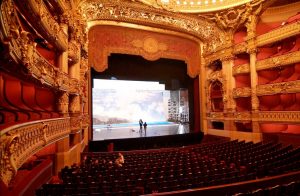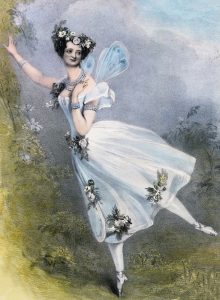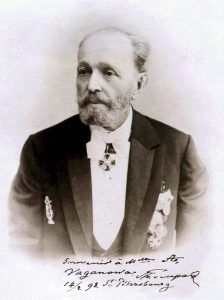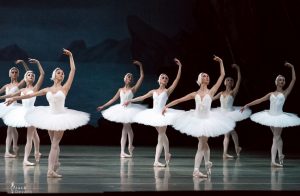From France and the royal academy, dance masters brought ballet to the other courts of Europe. These professional teachers and choreographers attended London, Vienna, Milan, and Copenhagen, where the monarchs supported ballet. During the 18th century, the French Revolution ended the French monarchy, and Europe saw political and social changes that profoundly affected ballet. By the 19th century, the Industrial Revolution resulted in middle-class people working in factories. Art shifted from glorifying the nobility to emphasizing the ordinary person.
The Romantic era of ballet reflected this pivotal time. Ballets had now become ballet d’action, ballets that tell a story. ballets that tell a story. The Romantic era was a time of fantasy, etherealism, supernaturalism, and exoticism. Artistic themes included man v.s. nature, good vs. evil, and society v.s. the supernatural. The dancers appeared as humans and mythical creatures like sylphs, wilis, shades, and naiads. Women were the stars of the ballets, and men took on supporting roles. Choreography now included pointework, pantomime, and the illusion of floating. Romantic ballets most often appeared as two-acts. The first act would be set in the real world, and dancers would portray humans. In contrast, the second act was set in a spiritual realm and often would include a tragic end.

The opera houses featured stages with prosceniums, a stage with a frame or arch. The shift of performance venues had a significant effect on ballet in the following ways:
The stagecraft of the time lent itself to creating the scenes that choreographer Filippo Taglioni would use in his ballets.

In 1824, ballet master Filippo Taglioni (1777-1871) choreographed La Sylphide. His daughter Marie portrayed the sylphide, an ethereal, spirit-like character. Marie Taglioni (1804-1884) wore a white romantic tutu with a bell-shaped skirt that reached below her knees, creating the effect of flight and weightlessness. Taglioni also removed the heels from her slippers and rose to the tips of her toes as she danced to give her movement a floating and ethereal quality. Taglioni is recognized as one of the first dancers to perform en pointe.
La Sylphide features a corps de ballet, a group of dancers working in unison to create dance patterns. Because the corps de ballet is dressed in white romantic tutus (as is the norm with sylphs, fairies, wilis, and other creatures that populate the worlds of Romantic ballet), La Sylphide is known as a ballet blanc.
Watch This
WATCH this video of the Royal Scottish Ballet that describes and shows excerpts from La Sylphide
Auguste Bournonville, a French-trained dancer, served the Royal Danish Ballet as a choreographer and director. Four years after the original La Sylphide production, Bournonville re-choreographed the ballet. Bournonville’s dances feature speed, elevation, and beats where the legs “flutter” in the air. He also expanded the lexicon of male dancing by adding ballon for men and stylized movements for women that portrayed them as sweet and charming. Bournonville created many dances for the Danish ballet, and the company has preserved his choreography through the centuries.
Watch This
The Bournoville variation from Napoli demonstrates movements of elevation
Giselle is a ballet masterwork that is still performed worldwide. It is inspired by the literary works of Heine and Hugo that referenced the supernatural wilis. Giselle was choreographed by Jean Coralli and Jules Perrot and composed by Adolphe Adam. It is almost a template for the traditional Romantic ballets. Act one is set in a village, and act two is in a graveyard, an otherworldly place populated by the ghosts of young girls who died before their wedding day; willis. Giselle falls in love with a young man, Albrecht, who pretends to be a local but is really a nobleman. Distraught by his deception, she dies from grief. When Albrecht visits her grave, the wilis conspire to dance him to death. Giselle, now a wili herself, intervenes to save him.
Not all Romantic era ballets were tragic and supernatural. Arthur St. Léon created the great comedic ballet Coppélia: The Girl with the Enamel Eyes. The ballet is based on a tale by E.T. A. Hoffman. It tells the story of a village boy, Franz, enamored by the girl Coppélia. Unbeknownst to him, she is an automaton. His jealous girlfriend Swanilda discovers the deception created by the doll’s creator, and when the old toymaker tries to animate his doll with magic, she takes the doll’s place and pretends to come to life. The characters’ antics were great hits with audiences, and the ballet remains popular today.
About the time King Louis XIV was sponsoring the creation of ballet in his court, Peter the Great became tsar of Russia (1682-1725). He embraced science and Western social ideas in an effort to bring “the enlightenment” to Russia. Peter built the imperial city of St. Petersburg and established his court there. His successor, Empress Anna, retained Jean-Baptiste Lande in 1738 to establish a ballet school at the military academy she had established. This school became the home of the Maryinsky Ballet. The Bolshoi Ballet was a rival school and company later established in Moscow.
Following Lande’s lengthy directorship in St Petersburg, many of Europe’s most important ballet masters and choreographers took a turn at the helm in creating dance in Russia, including Jules Perrot, Filippo Taglioni, and Arthur St Léon.
Marius Petipa was the most influential choreographer of this era, known as “The Father of Classical Ballet.” A dancer from a family of French ballet dancers, he moved to St Petersburg as a minor choreographer. He rose to great importance in Russian ballet as the director and choreographer of the Maryinsky Ballet for nearly sixty years (1847-1903). He created over sixty ballets in his career, restaging a number of the great Romantic era ballets (much of the existing choreography of ballets like Giselle and Coppélia is the work of Marius Petipa’s restaging.) Petipa also created new original ballets, beginning with The Pharaoh’s Daughter, a five-act ballet complete with an underwater scene and livestock onstage.

Marius Petipa is responsible for the defining characteristics of classical ballets. Petipa’s creations told stories using ballet, character dance, and choreographic structures that highlighted the most technical dancers of the company.
Petipa developed a standard choreographic structure. He used character dances, folk dances that depicted various cultures, to add variety to the performance. Unlike the Romantic ballets that consisted of two acts, classical ballets expanded to three or four acts. Many dances that had nothing to do with moving the plot forward were included in these ballets to make them longer. These extra dance numbers are called divertissements (diversions). Divertissements were often character dances. The end of the ballet usually features the grand pas de deux, a duet for the principal dancers. The grand pas de deux has four sections:
Watch This
The Sleeping Beauty grand pas de deux featuring Robert Bolle and Diana Vishneva.
Contextual Connections
Pyotr Ilyich Tchaikovsky composed three great ballets. He was already a recognized and respected composer in Russia when Petipa asked him to compose the ballet score for The Sleeping Beauty. Petipa gave Tchaikovsky specific instructions on the music he required for the ballet. The ballet was lavishly produced and became an enormous success.
Tchaikovsky’s second ballet, The Nutcracker, was choreographed by Petipa’s choreographic assistant, Lev Ivanov (1834-1901). Petipa’s choreographic assistant, Lev Ivanov, worked alongside Petipa in the creation of many ballets. He created entire portions of Petipa ballets and ballets of his own.
The Nutcracker was not admired in Russia at the time – it was seen as frivolous and trivial. It was in America in the middle of the twentieth century that the Nutcracker found popularity as a vehicle for local dancers in communities around the country.
The third well-known ballet Tchaikovsky composed was Swan Lake. Marius Petipa choreographed the first and third acts of the ballet- those set in the environs of Prince Siegfried, town and ballroom, and the world of people. Lev Ivanov choreographed acts two and four, the beautiful scenes set at the lake with the swans.

After the revolution of 1917, the Russian populace embraced ballet. Rather than discarding it as a symbol of the tsars, the working class adopted it as their own, and ballet became a symbol of national pride.
At the end of the 19th century, Russia was at the apex of the ballet world, and this continued well into the 20th century. The Vaganova Choreographic Institute in St Petersburg employs Russia’s finest teachers to train its dancers. The life of a ballet dancer in Russia brings privileges and opportunities that make acceptance into the school highly desirable.